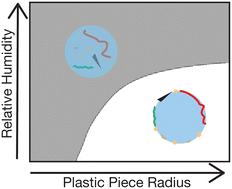Buoyancy and Brownian motion of plastics in aqueous media: predictions and implications for density separation and aerosol internal mixing state
Abstract
The low densities of many plastics compared to those of aqueous salt solutions has made density separation, relying on buoyancy overcoming Brownian motion, a convenient technique to separate nano- and microplastics from environmental matrices. Nanoplastics (smaller than about 1 μm) and microplastics (smaller than 5 mm) also exist in aqueous media in the environment, where they too will be buoyant or undergo Brownian motion and diffusion depending on their size and density. Recent evidence of plastics being introduced to the aerosol phase through bubble bursting and wave action indicates that sea-spray aerosol may contain nanoplastics, but the mixing state of this plastic in aerosol droplets is unknown. Here, the Peclet number (Pe) is used to first estimate the smallest plastics that can be separated from environmental matrices via density separation. These calculations predict that using a dense brine solution such as ZnCl2, plastics down into the nanoplastic size range can be separated. Pe is then calculated for polyethylene terephthalate (PET), polystyrene (PS) and polyethylene (PE) plastics as a function of relative humidity for NaCl, (NH4)2SO4 and citric acid aerosol. Calculated Pe values suggest that plastics smaller than 750 nm will always be dominated by Brownian motion regardless of relative humidity while larger plastics may become buoyant at low relative humidities.

- This article is part of the themed collection: Environmental fate of nanomaterials


 Please wait while we load your content...
Please wait while we load your content...